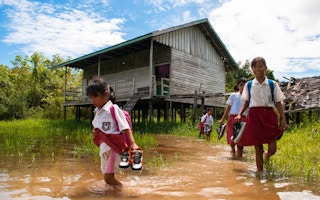Following nearly 30 years of advocating for financial support for loss and damage driven by climate change, at last year’s UN climate summit in Egypt (COP27), delegates achieved a breakthrough: COP27 took a decision to establish a fund for addressing loss and damage.
Since March this year, a Transitional Committee on loss and damage has been working to come up with a set of recommendations, among other things, on how the new fund should operate. Several challenges remain - however, there is a real opportunity to design the fund in a way that responds to the needs of vulnerable countries and communities.
This is urgent because catastrophic climate impacts are hitting all over the world, but the poorest and most marginalised are the worst impacted. Countries and communities - disproportionately those in the developing world - are being ravaged by cyclones, floods and droughts, and suffering the consequences of steady sea-level rise. They are paying the price of the rich historical emitters who continue to expand their use of fossil fuels, further exacerbating the crisis.
The writing is on the wall: countries have gone past the point where adaptation alone can arrest the climate impacts. Losses and damages are happening with ever-growing economic and non-economic costs. And they are expected to worsen because collective efforts to limit global warming are falling short as rich countries in particular fail to live up to their responsibility and historic climate debt.
This means that any development gains in the Global South will be further eroded, and its people, who are not responsible for the crisis, will suffer displacement and loss of infrastructure, lives and livelihoods. Such countries and communities - as a matter of justice - need urgent financial support. And designing the new fund will go a long way to deliver it.
Many contentious issues
However, there are continued points of disagreement between developed and developing countries, including discussions around what role the new fund will play in a mosaic of existing institutions; who will pay, who is eligible to receive funding and how easily it can be accessed; what will be funded; and what will be the sources and instruments of funding. Those issues are expected to dominate deliberations at the third meeting of the Transitional Committee in the Dominican Republic from August 29 to September 1.
“
The world can no longer afford to delay in assisting developing countries and communities. Nor can we allow the newly fund to remain an empty vessel.
Many of these issues are more political than technical - and can be resolved with political goodwill. More than half-way through the process of setting up the new fund, the meeting in Santo Domingo is critical in articulating a first draft charter or governing instrument detailing the fund’s core modalities and functions. The Committee’s final recommendations, expected in mid-October - which require consensus - must then be approved at the next climate summit in Dubai (COP28).
A set of civil society organisations representing the constituencies of environmental NGOs, and of women and gender groups of the UN’s climate body, the UNFCCC, have come together with solutions on how the new Loss and Damage Fund should operate to support affected countries and communities, as detailed in our proposed Governing Instrument.
Who gets what kind of money - and from where?
We expect the Loss and Damage Fund to be the main fund in the loss and damage finance landscape. We believe its purpose is to make a significant and ambitious contribution to provide new, additional, predictable and adequate financial support to assist developing countries and communities in comprehensively addressing and providing remedy for economic and non-economic loss and damage.
We are calling on developed countries - who have a moral and ethical obligation owing to their historical responsibilities in causing the climate crisis - to finance the fund exclusively in the form of grants and financial instruments that do not create debt. We believe this to be an issue of justice, as much as acknowledging that developing countries are already reeling under heavy, unsustainable debt burdens and need fiscal space to deal with unavoidable climate-linked losses and damages in the short- and long-term. We are also calling for all developing countries to receive financial support from the fund to address loss and damage.
Putting affected communities in the driver’s seat
The fund should be able to release funding in the aftermath of climate disasters and help to rebuild lives, livelihoods, wellbeing and infrastructure through rehabilitation and reconstruction measures. It must also provide funding for longer-term loss and damage - for permanent relocation, for instance, arising out of slow-onset events such as sea-level rise and melting of glaciers.
Accessing resources to tackle the climate crisis has traditionally been arduous for developing countries, and almost impossible for affected communities. In this regard, we are calling for a “community direct access window” that would provide small grants with no red tape for subnational and local actors - in particular affected communities, women, youth, Indigenous Peoples, people living with disability, and civil society groups working directly with them. This will ensure that the new fund applies lessons learned and addresses some of the worst shortcomings in the way funding for climate action is currently provided. “Trickle down” in climate finance does not work. Affected communities and people must be empowered to make local funding decisions.
It is also imperative that actions supported by the fund must respect, promote and consider human rights, including Indigenous rights, gender equality and intergenerational justice. This requires the public participation of affected communities and civil society organisation in the design, implementation, and monitoring and evaluation of the fund’s policies and activities.
Doing all this would set the new Loss and Damage Fund apart from existing climate funds.
The world can no longer afford to delay in assisting developing countries and communities. Nor can we allow the newly fund to remain an empty vessel. For true collective climate action to take root, developed nations must take immediate, meaningful steps. This is crucial for meeting the urgent and growing needs of people in developing countries, protecting their rights and livelihoods, and delivering climate justice, both in letter and in spirit.
This story was published with permission from Thomson Reuters Foundation, the charitable arm of Thomson Reuters, that covers humanitarian news, climate change, resilience, women’s rights, trafficking and property rights. Visit https://www.context.news/.












